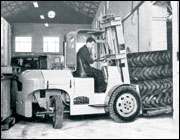 Members of the materials handling industry have been very responsive over many years in offering help to customers experiencing warehousing difficulties. In the past some manufacturers had equipment that could be adapted to form a ready-made solution, but others had to rely on innovative design. In 1958, one small company in the latter category was Matling of Wolverhampton, who came up with a novel solution to handling pallets of differing sizes and construction. The unique feature of their 4000lb capacity pallet transporter was that the forks could be retracted hydraulically. This could be done either separately or together from a length of 42 inches down to 26 inches, giving two major benefits.
Members of the materials handling industry have been very responsive over many years in offering help to customers experiencing warehousing difficulties. In the past some manufacturers had equipment that could be adapted to form a ready-made solution, but others had to rely on innovative design. In 1958, one small company in the latter category was Matling of Wolverhampton, who came up with a novel solution to handling pallets of differing sizes and construction. The unique feature of their 4000lb capacity pallet transporter was that the forks could be retracted hydraulically. This could be done either separately or together from a length of 42 inches down to 26 inches, giving two major benefits.
One such benefit was that the fork wheels could be adjusted to fit between the bottom deck boards on the pallet, and the other was that the shortening of the forks could have been of major help in situations where floor space was restricted on withdrawal of the truck after unloading. In addition the forks could also be positioned to avoid any irregularities in the loading platform floor. All hydraulically operated movements were controlled by a hand wheel, which was rotated to preselect the movement required and depressed to close a microswitch, which would apply power.
Released at the International Mechanical Handling Exhibition in May 1958 was news of the latest truck from Matbro. The Series 111 counterbalance was designed with torque converter transmission and power steering. Lifting capacities were available in 2, 3 and 4 ton models, all capable of indoor or outdoor operation.
Continuing further into 1958, Linde established a hydraulics department within their company. The department would later become the Companies Industrial Trucks and Hydraulics Division. In this same year they produced their first forklift trucks with hydrostatic transmission. This followed on from the production of their first car with this type of transmission, the “Hydrocar”, in 1956.
About the same time, in Sweden Knut Jacobsson established a forklift truck company in Gothenburg. Initially registered under the name of `Elitmaskiner,` this family business, later to be named `Atlet`, produced and sold hand pallet trucks. In the interest of economy these hand-built machines were first sold by mail order to Swedish-based customers.
On a slightly larger scale 1958 also heralded the birth of yet another American forklift manufacturer, although – not for the first time in this history – this was not the deliberate intention of the company concerned. Namco, later named Namco Schaef, were very successful at the time in making agricultural machinery, but found it difficult finding a suitable piece of handling equipment to suit their production operation. Like a few other companies – Clark and Matbro come to mind – Namco entered the materials handling industry by making a piece of lifting equipment to suit their own use. Some time later, it became evident that with design improvements and modifications, this type of equipment could be offered for sale. This became a reality some three years later as one of the company’s first products to be produced from its new facility, which was located East of Sioux City USA.
By James Brindley, Director, National Fork Truck Heritage Centre
To be continued…




Comments are closed.